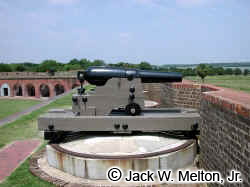Captain Theophilus Alexander Blakely
Captain Blakely had tried unsuccessfully to sell his cannon to the British government and felt
that Sir William George Armstrong had infringed upon his patents. Since Armstrong was
appointed as superintendent of the Royal Gun Factory at Woolwich, Blakely decided not to
offer any further cannon. Approximately two of the four-hundred guns that Blakely had produced were
made of steel and the other half were manufactured with cast-iron strengthened by steel.
The Confederacy purchased a number of Blakely rifles from 2.5-inch caliber to
the large 12.75-inch Blakely
used in Charleston, South Carolina. Two 4.5-inch caliber Blakely's were
used at Fort Pulaski in Savannah, Georgia. Blakely had no means to manufacture his cannon and relied solely on others for
their manufacture. Fawcett, Preston, & Company, Low Moor Iron Company, and the Blakely
Ordnance Company of London (Blakely was thought to have interest) were the main foundries
responsible for producing Blakely rifles. Most Blakely rifles have the
"hook-slant" rifling similar to the Brooke system. Below are
some examples of the Blakely projectile.
other half were manufactured with cast-iron strengthened by steel.
The Confederacy purchased a number of Blakely rifles from 2.5-inch caliber to
the large 12.75-inch Blakely
used in Charleston, South Carolina. Two 4.5-inch caliber Blakely's were
used at Fort Pulaski in Savannah, Georgia. Blakely had no means to manufacture his cannon and relied solely on others for
their manufacture. Fawcett, Preston, & Company, Low Moor Iron Company, and the Blakely
Ordnance Company of London (Blakely was thought to have interest) were the main foundries
responsible for producing Blakely rifles. Most Blakely rifles have the
"hook-slant" rifling similar to the Brooke system. Below are
some examples of the Blakely projectile.
3.5-inch Blakely Shell
4.0-inch Blakely Shell
Blakely Sub-Pattern II
Blakely Sub-Pattern II
Blakely Sub-Pattern II
Blakely Sub-Pattern II